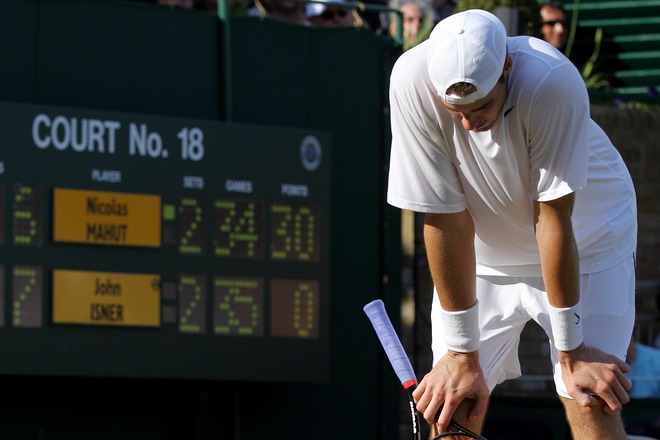By Charles Bricker
OK, it’s legendary. OK, these two warriors — spiky haired Nicolas Mahut (“mah-oo”) of France and 6-foot-9 John Isner — were out there nearly seven hours on Wednesday, unable to finish a match that was called because of bad light at 9:09 p.m. and the score, incredibly, at 59-all in the fifth set.
Isner was barely shuffling along. He came back from a bathroom break, about 10 minutes before tournament referee Andrew Jarrett stepped into the ring and waived both boxers off to their respective beds, and he was gripping the handrail to help climb the stairs.
And OK, the crowd, chanting “We want more” as Jarrett came on court to make his call, was loving it, while twitters or tweeters — whatever they call themselves — were jotting out things on the internet like, “Wow, incredible,” and “these guys are gladiators.”
But when we clear away the dust and the ridiculous statistics that will flow from this match, if it’s ever finished, you’re entitled to ask, “Is this tennis?”
The U.S. Open is the only Grand Slam that has gotten it right. When the Open became the first major to order tiebreaks in 1970, it insisted that the fifth set be settled by a tiebreak as well.
Australia, the French and Wimbledon did not follow that lead and, admittedly, it has led to some great fifth-set theater. Just last year, Roger Federer beat Andy Roddick 16-14 in the fifth for the title. But that was for a trophy. Isner-Mahut is a first-round match and after nearly 10 hours of tennis, these guys were just about out on their feet.
In the final analysis, qualifier Mahut is not going to come close to winning Wimbledon if he comes out on top and Isner, if he is triumphant Thursday, will be so dog-tired he could be out in the second round.
Which brings up another question. Assuming this thing gets over quickly tomorrow, will the winner have to play his second round match the same day, against young Thiemo de Bakker, to keep everyone else in his quadrant in the same competitive situation?
There were only two breaks in the match and none in the final set, and one of the key reasons why this thing went on interminably was because both players no longer had the quick-twitch muscle freshness to react to the others’ serves. There were 138 aces in the final set alone, 68 by Mahut, who erased the fourth match point of this circus at 58-59 — a blast up the T that left Isner with the bat on his shoulder.
I watched a couple hours, fascinated, like everyone else. And then tedium crept in. This wasn’t anything like watching Federer-Roddick, as each jockeyed for a break point with a Grand Slam title as the reward. When there was about 45 minutes of light left, I got back to the match. It was more of the same until Jarrett intervened.
As the players headed back to their lodgings, they had played 608 points in the final set. Combined, there were 460 winners and 61 unforced errors in the last set alone. Great playing, you think? Hardly. The rallies were so short no one had much of a chance to commit an unforced error.
And what of the skewed statistics from this match. I’ve got Isner for 98 aces, by far a record at this point. Isner is among the ace leaders in men’s tennis, but is it reasonable that his 98 or 100 or 150 aces, whatever his final total, become a record that will never be broken — not by Andy Roddick, Ivo Karlovic or anyone else?
The Brits will be back on Court 18 on Thursday to watch the finish and, as they did Wednesday, to stand and cheer two valiant players. They will have witnessed the finish of something you’ll probably never see again.
And let’s hope we don’t.
Charles Bricker can be reached at nflwriterr@aol.com

